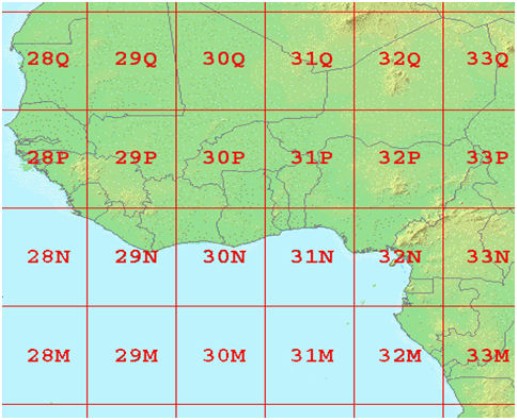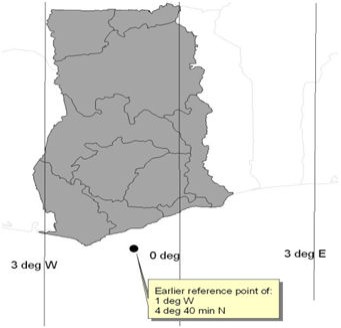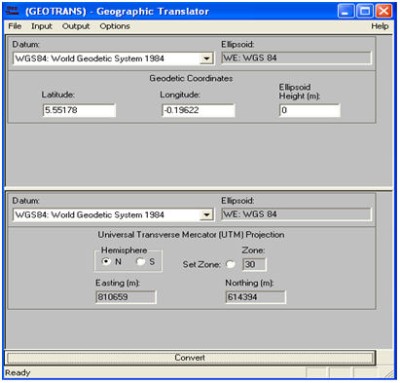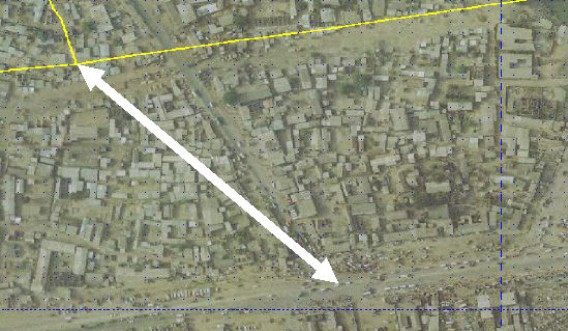LUPMIS
Main menu:
- Home Page
- 1. Background and time frame
- 2. Community Orientation and GIS
- 3. Expected IS activities and output
- 4. Sites of installation and communications
- 5. Data sharing with other LSAs
- 6. Network
- 7. Software
- 8. Human resources and training
- 9. Work activities
- 10. Conclusions and future IS developments
- Annexes
- Annex 1: Projection and datum
- Annex 2: Procurement plan
- Annex 3: Justification of procurement items
- Annex 4: Standards
- Annex 5: Possible scenarios of GIS analyses for land use planning
- Annex 6: DBMS for permits
- Annex 7: GPS mapping
- Annex 8: Data request for GIS
- Annex 9: Financial considerations
- Annex 10: Land use planning activities with IS
- Annex 11: Planning chart: Tasks
- Annex 12: Work programme: Tasks
- Annex 13: Pilot communities
- Annex 14: Coverage of orthophotos for LAP
- Annex 15: Training content
- Annex 16: Glossary
Annex 1: Projection and datum
Annexes
Annex 1: Projection and Datum
A1.1) Introduction
There are various projections and datum definitions, which are or have been applied in Ghana and result in some confusion and inaccuracy of mapping and surveys.
(Technical definition: A datum is a set of reference points on the earth's surface against which position measurements are made, and (often) an associated model of the shape of the earth (ellipsoid) to define a geographic coordinate system. Horizontal datums are used for describing a point on the earth's surface, in latitude and longitude or another coordinate system. Vertical datums measure elevations or depths'. A datum is defined by the ellipsoid and the shift of the x,y,z origin).
One of the first datum was the Accra Datum 1929 used for the ellipsoid of War Office 1926 (also McCaw 1924), which can still be found on recent maps (e.g. on some 1:2,500 topo). Earlier maps had imperial units (‘Gold Coast feet’, not UK feet, equals 0.3047997 m), recent maps have metric units. The War Office projection (rectangular polyconic projection) has been defined 1853 and was mainly used in the late 19 century.
In 1977 the datum was changed to Leigon Datum 1977 used for the ellipsoid of Clarke 1880 (modified). This system is shown on some current maps (e.g. on some 1:50,000 topo), all with metric units.
‘The problem of incompatible projections and conversion between mapping systems is of general concern to those involved in the collection of natural resources data. The Ghana National Grid (GNG) is an example of a mapping system that is not defined in image processing and GIS software and for which the transformation parameters are not readily available in the literature. Consequently, integrating GNG topographic map data within a GIS with data derived from other sources can be problematic.’ ( reference).
A1.2) GIS and datum
The problem of having different datums was not recognized as a major problem in the past, because most GIS applications have been applied on small or medium scales, where errors due to different datums of upto 100-500 m do not show.
Agencies (LSAs) or institutes have different requirements for the tolerance of acceptable error, depending on the operating scale, either larger or smaller scales. At the NLIS, with mapping and inventories of parcels and cadastres, higher accuracy than the beforementioned of 100-500 m is required, together with high compatibility.
For map data at LUPMIS, a maximum error of 10 m can be accepted, which is derived from a compromise between cost efficiency and financial sustainability, projection and datum definitions, (handheld) GPS accuracy (DOP), map reading skills of surveyors, i.e. at the maximum scale of 1:2,500, and the accuracy to be expected for the tasks of TCPD.
To be precise at that accuracy level, consistent within the NLIS, and technologically applicable, the Consultant strongly recommends to update and use a national grid (including projection and datum) as fast as possible for all mapping activities in Ghana, to be used with all GPS and on all GIS software, which is also easy to use, well documented and in accordance with international standards.
(Technical remark: If a higher horizontal accuracy is required, following requirements exist:
- For maximum of 3m positional error: All (handheld) GPS have to be equipped with a high accuracy chip (e.g. Sirf III for PDA/GPS), all image data have to be re-georeferenced with newly collected ground control points, newly acquired images have to meet the Precision level of imagery (CE90: 4.1 m, RMS: 1.9 m), collected vector maps have to be checked and also re-georeferenced (either with conversion parameters, or re-calibrated)
- For a submeter positional accuracy: GPS have to be single-frequency GPS retriever or data from handheld GPS to be postprocessed, if synchronous GPS data from a reference base station within a distance of less than 50-100 km are available), all image data have to be re-georeferenced with newly collected ground control points, newly acquired images (only QuickBird) have to meet the PrecisionPlus level of imagery (CE90: 2.0 m, RMS: 0.9 m), collected vector maps have to be checked and also re-georeferenced (either with conversion parameters, or re-calibrated)
A1.3) WGS 84 and UTM
WGS84 is the most commonly used contemporary datum, based on highly accurate and most recent measurement of the shape of the earth. WGS84 is the default standard datum for coordinates stored in all commercial GPS units (see also Annex 7: GPS Mapping). It is also incorporated in all GIS software. This will enable the professional and easy use of GPS and GIS. Many GPS do not enable the collection of data on other systems than the WGS 84.
The same system can also be applied by NLIS (LAP) and all LSAs.
Differences of point coordinates measured by different datums can amount to the range of seconds, i.e. 300 m or more, well beyond the accuracy of GPS.
The UTM system is the highest standard of projection applied worldwide, with a high level, well-defined accuracy (below 1 part in 1,000). It is easy to handle in the field due to its units of meters. Most, if not all of the neighbouring countries of Ghana use the UTM system. Introducing and implementing the UTM projection is therefore also in accordance with the other countries of the region.
A1.4) Proposed projection and datum for Ghana
In Ghana, UTM zone 30 applies (see figure A1.2 below). Beside these many advantages of applying such a precise, most up-to-date system, the only disadvantage might be a slightly higher error in the extreme East of the country, if zone 30 is applied on a national scale. On large scale, maps can easily be transferred to UTM zone 31 in these few areas in the extreme East to resolve this problem.
At TCPD, the Consultant recommends the UTM projection based on WGS 84, in order to apply a modern, adequate system, which is accurate, has not to be changed within a few years and which can easily be used by surveyors and planners in the field with GPSs.
| Ghana Grid (1926-77) |
Ghana Grid (1977-) |
Ghana Grid (proposed) |
||
| Projection: | TM (Gauss-Schreiber) |
TM (Gauss-Krueger?) |
UTM | |
| Origin W/E (deg) | -1 | -1 | -3 | |
| Origin N (deg) | 4.666,66 | 4.666,66 | 0 | |
| Origin scale | 0.999,75 | 0.999,75 | 0.999,60 | |
| False coord x E (m) | 274,320 | 300,000 | 500,000 | |
| False coord y N (m) | 0 | 0 | 0 | |
| Datum (conversion to WGS 84): | Accra 1929 (1) | Leigon 1977 | WGS 84 | |
| Shift dx (m) (2) | -199 | -130 | - | |
| Shift dy (m) (2) | 32 | 29 | - | |
| Shift dz (m) (2) | 322 | 364 | - | |
| da (m) (3) | -81.5 | -56 | - | |
| df (*10exp-4) (4) | -0.255 | -0.547 | - | |
| Rotation rx (5) | ? | ? | - | |
| Rotation ry (5) | ? | ? | - | |
| Rotation rz (5) | ? | ? | - | |
| Datum scale (ppm) (5) | ? | ? | - | |
| Ellipsoid | War Office 1926 |
Clarke 1880 (RGS/mod) |
WGS 84 | |
| Semi-major axis (a, m) | 6,378,300.00 | 6,378,249.145 | 6,378,137.00 | |
| Semi-minor axis (b, m) | 6,356,751.690 | 6,356,514.870 | 6,356,752.314 | |
| Flattening (1/f) | 296.000 | 293.465 | 298.257 | |
| Eccentricity (e) | 0.082,130,04 | 0.082,483,40 | 0.081,819,19 | |
| 2nd eccentricity (e') | 0.082,408,45 | 0.082,765,43 | 0.082,094,44 | |
Table A1.1: Projection, datum and ellipsoid parameters
Remarks:
(1) In earlier days, the War Office 1853 datum was used
(2) Local datum shift is based on literature research (see footnote above), but not tested positively against Survey Dept maps, see also last footnote in this Annex for other versions of parameters
(3) Calculated as a (WGS84) / 2 - a(ellipsoid) / 2, useful for User Datum definitions at GPS and GIS
(4) Calculated as f(WGS84) - f(ellipsoid) ) * 10,000, useful for User Datum definitions at GPS and GIS
(5) Rotation parameters and datum scale are required for accurate 7-parameter transformation (Helmert, Bursa-Wolf), but not for less accurate 3-parameter transformation (geocentric translation, Molodensky)

Figure A1.1: West Africa with the UTM grid system

Figure A1.2: Ghana with UTM zones
In an interim period, until final decision has been made, data will be collected in the field and stored in the GIS system, using the latitude / longitude system or the UTM 30 projection, but all based on WGS 84.
The coordination conversion package Geographic Transformer to convert to / from different projections and datums is highly recommended for the ease of its use.

Figure A1.3: Screen of software for coordinate conversion
This software has been ‘fudged’ (i.e. adjusted based on empirical error minimization), but research still takes place (as of October 2007) to adjust the conversion to / from War Office definition in precise, geodetic terms. Alternatively, different conversion software with predefined War Office conversion has to be searched for, and procured, to enable - at least in the interim period - a conversion from collected GPS coordinates to the War Office system to be done with the expected accuracy.
At this moment, such a conversion to use GPS readings with the available maps is not possible.

Figure A1.4: Demonstration of georeference distortion:
The orthophoto of Kasoa has been sampled from War Office,
the yellow line in the upper part of the photo is the track of the road with GPS / WGS 84 (in lat/long).
Distance between these two presentations of the same location is 120-150 m
Latest research proposes following parameters for conversion from Ghana Grid to WGS 84:
| 5-parameters | 7-parameters | ||
| Datum (conversion to WGS 84): | |||
| Shift dx (m) | -196.24 | -145.95 | |
| Shift dy (m) | 33.38 | 31.45 | |
| Shift dz (m) | 322.76 | 327.94 | |
| da (m) | -163 | - | |
| df (rd) | -2.5567 * 10exp-5 | - | |
| Rotation rx (rd) | - | 1.443 * 10exp-6 | |
| Rotation ry (rd) | - | -1.193 * 10exp-8 | |
| Rotation rz (rd) | - | 5.383 * 10 exp-9 | |
| Datum scale | - | 0.999,992,069 | |
Sub-Menu:
- Annex 1: Projection and datum ←
- Annex 2: Procurement plan
- Annex 3: Justification of procurement items
- Annex 4: Standards
- Annex 5: Possible scenarios of GIS analyses for land use planning
- Annex 6: DBMS for permits
- Annex 7: GPS mapping
- Annex 8: Data request for GIS
- Annex 9: Financial considerations
- Annex 10: Land use planning activities with IS
- Annex 11: Planning chart: Tasks
- Annex 12: Work programme: Tasks
- Annex 13: Pilot communities
- Annex 14: Coverage of orthophotos for LAP
- Annex 15: Training content
- Annex 16: Glossary